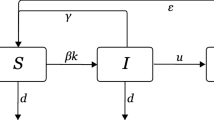Abstract
We derive a stochastic SIS pairwise model by considering the change of the variables of this system caused by an event. Based on approximations, we construct a low-dimensional deterministic system that can be used to describe the epidemic spread on a regular network. The mathematical treatment of the model yields explicit expressions for the variances of each variable at equilibrium. Then a comparison between the stochastic pairwise model and the stochastic mean-field SIS model is performed to indicate the effect of network structure. We find that the variances of the prevalence of infection for these two models are almost equal when the number of neighbors of every individual is large. Furthermore, approximations for the quasi-stationary distribution of the number of infected individuals and the expected time to extinction starting in quasi-stationary are derived. We analyze the approximations for the critical number of neighbors and the persistence threshold based on the stochastic model. The approximate performance is then examined by numerical and stochastic simulations. Moreover, during the early development phase, the temporal variance of the infection is also obtained. The simulations show that our analytical results are asymptotically accurate and reasonable.








Similar content being viewed by others
References
Albert R, Barabasi AL (2001) Statistical mechanics of complex networks. Revi Mod Phys 74(1):47–97
Allen LJS (2010) An introduction to stochastic processes with applications to biology, 2nd edn. CRC Press, Boca Raton
Anderson RM, May RM (1991) Infectious diseases of humans: dynamics and control. Oxford University, Oxford
Anderson RM, May RM (1992) Infectious diseases of humans. Oxford University Press, New York
Andersson H, Britton T (2000) Stochastic epidemic models and their statistical analysis. Springer, Berlin
Andersson P, Lindenstrand D (2011) A stochastic SIS epidemic with demography: initial stages and time to extinction. J Math Biol 62(3):333–348
Ball F, House T (2017) Heterogeneous network epidemics: real-time growth, variance and extinction of infection. J Math Biol 75(3):577–619
Ball F, Britton T, Leung KY, Sirl D (2019) A stochastic SIR network epidemic model with preventive dropping of edges. J Math Biol 78(6):1875–1951
Barbour AD (1972) The principle of the diffusion of arbitrary constants. J Appl Probab 9(3):519–541
Barbour AD (1976) Quasi-stationary distributions in Markov population processes. Adv Appl Probab 8(2):296–314
Black AJ, House T, Keeling MJ, Ross JV (2014) The effect of clumped population structure on the variability of spreading dynamics. J Theor Biol 359:45–53
Britton T, Neal P (2010) The time to extinction for a stochastic SIS-household-epidemic model. J Math Biol 61(6):763–779
Britton T, Traoré A (2017) A stochastic vector-borne epidemic model: quasi-stationarity and extinction. Math Biosci 289:89–95
Callaway DS, Newman MEJ, Strogatz SH, Watts DJ (2000) Network robustness and fragility: percolation on random graphs. Phys Rev Lett 85(25):5468
Colizza V, Barrat A, Barthélemy M, Vespignani A (2006) The modeling of global epidemics: stochastic dynamics and predictability. Bull Math Biol 68(8):1893–1921
Dangerfield CE, Ross JV, Keeling MJ (2009) Integrating stochasticity and network structure into an epidemic model. J R Soc Interface 6(38):761–774
Ferguson NM, Keeling MJ, Edmunds WJ, Gani R, Grenfell BT, Anderson RM, Leach S (2003) Planning for smallpox outbreaks. Nature 425(6959):681–685
Gillespie DT (2002) The chemical Langevin and Fokker–Planck equations for the reversible isomerization reaction. J Phys Chem A 106(20):5063–5071
Graham M, House T (2014) Dynamics of stochastic epidemics on heterogeneous networks. J Math Biol 68(7):1583–1605
Grimmett GR, Stirzaker DR (2001) Probability and random processes. Oxford University Press, New York
Hethcote HW (2000) The mathematics of infectious diseases. SIAM Rev 42(4):599–653
Keeling MJ, Ross JV (2008) On methods for studying stochastic disease dynamics. J R Soc Interface 5(19):171–181
Kurtz TG (1970) Solutions of ordinary differential equations as limits of pure jump Markov processes. J Appl Probab 7:49–58
Kurtz TG (1971) Limit theorems for sequences of jump Markov processes approximating ordinary differential processes. J Appl Probab 8(2):344–356
Luo XF, Jin Z (2020) A new insight into isolating the high-degree nodes in network to control infectious diseases. Commun Nonlinear Sci Numer Simul 91:105363
Miller JC, Slim AC, Volz EM (2011) Edge-based compartmental modeling for infectious disease spread part I: an overview. J R Soc Interface 9(70):890–906
Nåsell I (1995) The threshold concept in stochastic epidemic and endemic models. In: Mollison D (ed) Epidemic models: their structure and relation to data. Cambridge University Press, Cambridge, pp 71–83
Nåsell I (1999) On the time to extinction in recurrent epidemics. J R Stat Soc B 61(2):309–330
Newman MEJ (2003) The structure and function of complex networks. SIAM Rev 45(2):167–256
Nipa KF, Jang SRJ, Allen LJ (2021) The effect of demographic and environmental variability on disease outbreak for a dengue model with a seasonally varying vector population. Math Biosci 331:108516
Pastor-Satorras R, Vespignani A (2001) Epidemic spreading in scale-free networks. Phys Rev Lett 86(14):3200–3203
Rand DA (1999) Correlation equations and pair approximations for spatial ecologies. Adv Ecol Theory 12(3–4):100–142
Ross JV (2006) A stochastic metapopulation model accounting for habitat dynamics. J Math Biol 52(6):788–806
Shaw LB, Schwartz IB (2010) Enhanced vaccine control of epidemics in adaptive networks. Phys Rev E 81(4):046120
Taylor HM, Karlin S (1998) An introduction to stochastic modeling, 3rd edn. Academic Press, New York
Van Kampen NG (1983) Stochastic processes in physics and chemistry. Phys Today 36(2):78–80
Van Mieghem P, Omic J (2013) In-homogeneous virus spread in networks. Mathematics 17(1):1–14
Van Mieghem P, Omic J, Kooij R (2009) Virus spread in networks. IEEE/ACM Trans Netw 17(1):1–14
Wang JR (1993) A calculation method of exponential matrices \({{\rm e}}^{A}\) and \({{\rm e}}^{At}\). J Math Technol 9(1):60–64
Acknowledgements
This work was supported by National Natural Science Foundation of China (Nos. 11971279, 61873154).
Author information
Authors and Affiliations
Corresponding author
Ethics declarations
Conflict of interest
The authors declare that they have no conflict of interest.
Additional information
Publisher's Note
Springer Nature remains neutral with regard to jurisdictional claims in published maps and institutional affiliations.
Rights and permissions
About this article
Cite this article
Jing, X., Liu, G. & Jin, Z. Stochastic dynamics of an SIS epidemic on networks. J. Math. Biol. 84, 50 (2022). https://doi.org/10.1007/s00285-022-01754-y
Received:
Revised:
Accepted:
Published:
DOI: https://doi.org/10.1007/s00285-022-01754-y




